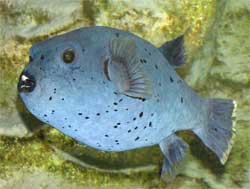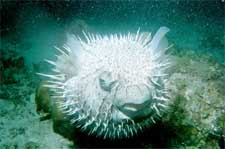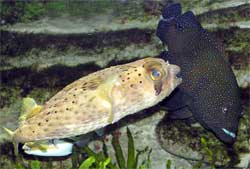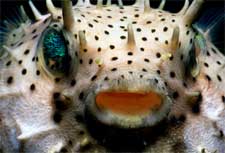|

 Wild Eyes: Pufferfish are able to move their eyes independently, and many species can change the color or intensity of their patterns in response to environmental changes. In these respects they are somewhat similar to the terrestrial Chameleon. Pufferfish are also one of few kinds of fish that can blink or close their eyes. (Some claim they are the only fish that can close their eyes, but certain attacking sharks close their eyes to protect themselves from struggling prey.) Wild Eyes: Pufferfish are able to move their eyes independently, and many species can change the color or intensity of their patterns in response to environmental changes. In these respects they are somewhat similar to the terrestrial Chameleon. Pufferfish are also one of few kinds of fish that can blink or close their eyes. (Some claim they are the only fish that can close their eyes, but certain attacking sharks close their eyes to protect themselves from struggling prey.)

We are family: There are 185 known species of the family Tetraodontidae, of which 38 can be found in Japan. They can be found worldwide from about 45° latitude north to 45° latitude south, mostly in salt water near coral reefs or the shore, but some species also live in fresh water and brackish water.
 Puffed up pride: The pufferfish's unique and distinctive natural defenses are necessary due to its slow speed. Pufferfish use a combination of pectoral, dorsal, anal, and caudal fins for propulsion, making it unmaneuverable and an easy target for predators. As a defense mechanism, pufferfish have the ability to inflate rapidly, filling their extremely elastic stomachs with water (or air when outside the water) until they are almost spherical in shape. Thus, a hungry predator stalking the pufferfish may suddenly find itself facing what seems to be a much larger fish and pause, giving the pufferfish an opportunity to retreat to safety. Puffed up pride: The pufferfish's unique and distinctive natural defenses are necessary due to its slow speed. Pufferfish use a combination of pectoral, dorsal, anal, and caudal fins for propulsion, making it unmaneuverable and an easy target for predators. As a defense mechanism, pufferfish have the ability to inflate rapidly, filling their extremely elastic stomachs with water (or air when outside the water) until they are almost spherical in shape. Thus, a hungry predator stalking the pufferfish may suddenly find itself facing what seems to be a much larger fish and pause, giving the pufferfish an opportunity to retreat to safety.
Last Line of Defense: Pufferfish also produce a powerful neurotoxin in their internal organs, making them a lethal meal for most predators including humans. This neurotoxin is found primarily in the ovaries and liver, although smaller amounts exist in the intestines and skin, as well as trace amounts in muscle tissue and in its blood. This last line of defense may induce an evolutionary aversion to pufferfish in other creatures, as those organisms which are predisposed to hunt pufferfish quickly perish after eating their prey.

 Puffer Poison: Pufferfish toxin is called tetrodotoxin, or more precisely anhydrotetrodotoxin 4-epitetrodotoxin. It is also found within other animals such as the Blue-Ringed Octopus and in certain varieties of newt. Tetrodotoxin is produced within the pufferfish by bacteria, which are acquired through food. This means that pufferfish raised in captivity do not contain tetrodotoxin, and therefore are not poisonous until they come into contact with the bacteria. The pufferfish itself has immunity to the poison due to a mutation in the protein sequence of the sodium channel pump on the cell membranes. Puffer Poison: Pufferfish toxin is called tetrodotoxin, or more precisely anhydrotetrodotoxin 4-epitetrodotoxin. It is also found within other animals such as the Blue-Ringed Octopus and in certain varieties of newt. Tetrodotoxin is produced within the pufferfish by bacteria, which are acquired through food. This means that pufferfish raised in captivity do not contain tetrodotoxin, and therefore are not poisonous until they come into contact with the bacteria. The pufferfish itself has immunity to the poison due to a mutation in the protein sequence of the sodium channel pump on the cell membranes.
Tetrodotoxin is an exceptionally lethal poison. Tetrodotoxin is approximately 1200 times deadlier than the neurotoxin cyanide. In animal studies with mice, 8 µg tetrodotoxin per kilogram of body weight killed 50% of the mice (see also LD50). It is estimated that a single pufferfish has enough poison to kill 30 adult humans. Some also believe that there is also enough poison to kill up to a dozen elephants.
Plate of Poison: The eyes and internal organs of most pufferfish are highly toxic, but nevertheless the meat is considered a delicacy in Japan and Korea. Pufferfish poisoning usually occurs as a result of accidental consumption of fish or meat tainted with pufferfish. Treatment consists of supportive care and intestinal decontamination with gastric lavage and activated charcoal. Case reports suggest that anticholinesterases such as edrophonium may be effective.
 That's One Small Genome: Due to some unknown selection pressure, intronic and extragenic sequences have been drastically reduced within this family. As a result, they have the smallest-known genomes yet found amongst the vertebrate animals, while containing a genetic repertoire very similar to other fishes and thus comparable to vertebrates generally. Since these genomes are relatively compact it's relatively fast and inexpensive to compile their complete sequences, as has been done for two species (Takifugu rubripes and Tetraodon nigroviridis). That's One Small Genome: Due to some unknown selection pressure, intronic and extragenic sequences have been drastically reduced within this family. As a result, they have the smallest-known genomes yet found amongst the vertebrate animals, while containing a genetic repertoire very similar to other fishes and thus comparable to vertebrates generally. Since these genomes are relatively compact it's relatively fast and inexpensive to compile their complete sequences, as has been done for two species (Takifugu rubripes and Tetraodon nigroviridis).
Trivia
Dolphins have been observed using pufferfish as a sort of toy in the wild. They tease the pufferfish with their teeth, causing the small fish to become alarmed and then inflate. After a while the fish calms down and deflates, thus starting the cycle over again.
When lifted out of water, pufferfish can inflate with air, but they may have problems deflating again afterwards. When this happens with aquarium specimens, fishkeepers hold the puffer underwater by the tail, head upwards, and shake the fish gently until the air escapes out of the mouth.
All text is available under the terms
of the GNU Free Documentation License |